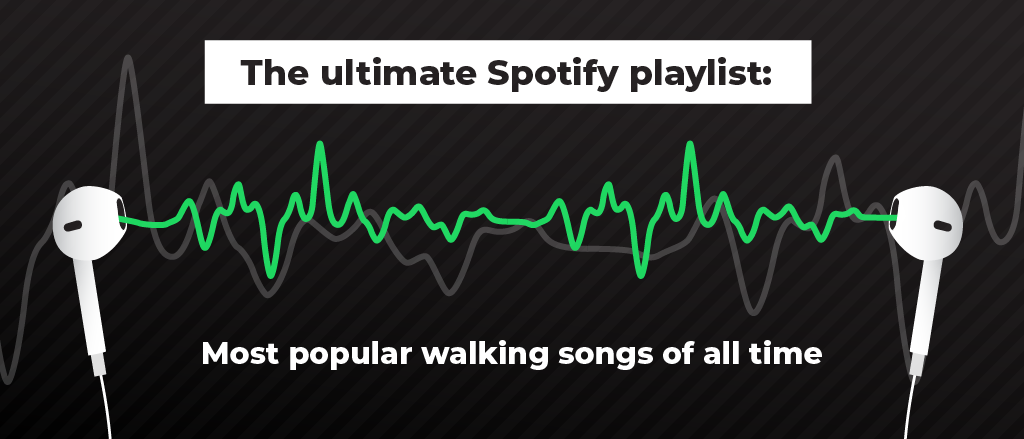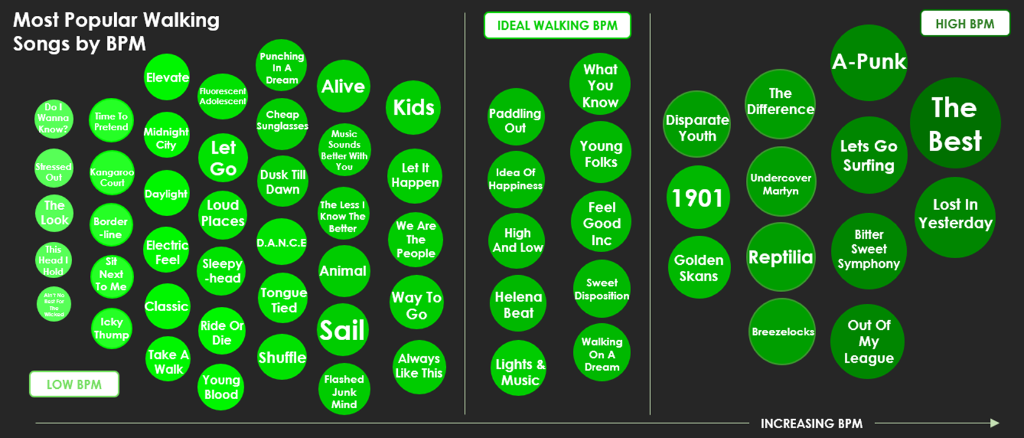
Average Google searches for ‘walks near me’ increased by 190% between March 19 – February 20 and the same period in 20/21. After the past year, it’s no surprise that more of us than ever have slipped on our walking shoes and gone for a stroll!
For many, music is an integral part of everyday life.
Not only can certain tunes change our moods, but studies have shown that music prompts the brain to release dopamine – a hormone that helps to regulate motivation and boost goal-orientated behaviour. One everyday activity where this comes in especially handy is walking.
We wanted to dig deeper into the ‘walking music’ tastes of the world, so we analysed a whopping 3,067 songs from playlists with an average of 206,147 monthly listeners on Spotify, to identify the most popular walking songs. We investigated the impact of beats per minute (BPM) on endurance, the most popular genres and more incredible benefits of music.
To top it off, we’ve created the ultimate playlist, featuring over four hours of motivational greatness. Listen to the full playlist on Spotify, here.
What makes some songs more stomp-worthy than others?
It’s widely believed that music encourages you to synchronise your steps to the beat – a great example of this is in marching bands. Even if you have two left feet and a terrible sense of rhythm, a catchy tune with a strong beat is nearly impossible to not tap your foot to!
But, what is it that makes certain music more tap-inducing than others? Though several factors can increase the likelihood of you treading in time, BPM is a key culprit.
What is BPM and what impact can it have?
The tempo of a piece of music is the speed at which it plays – this is measured by the number of beats per minute, otherwise known as BPM. This means that if a tempo is 60 BPM, a beat would sound once each second.
According to Relationship and Mind Coach, Md Ansar Ali, the ideal BPM for walking and other workouts is between 125 and 140 beats per minute. The benefits of choosing tracks within this tempo range can be great, with studies showing that listening to music can even increase performance.
He told us, “while people’s preferred step frequency varies when walking and running, scientists have discovered that the addition of a strong, rhythmic beat, such as a fast-paced musical track, could inspire people to pick up the pace.”
The average BPM in our Spotify favourites playlist is 123 BPM – right on the cusp of that holy grail range (though of course, the ideal BPM for you depends on your age, fitness levels and speed preference). We filtered our most popular songs to walk to by BPM to find the best of an already brilliant bunch:

How does music affect memories and motivation?
Not only can music encourage you to get up off the couch and move, but it can help you to keep moving, too. We spoke to Juggy Sidhu, Founder of the Lean Indian Academy, who told us:
“Your music choices may help you as a distraction tool from the hill climbs you may experience, where the legs burn just a little more and you feel slightly breathless, or it can act as a powerful motivator for you to increase your walking intensity and push through.”
If you struggle with willpower, Juggy explains that the mind can often associate walking for exercise with negative experiences such as pain, muscle soreness and feelings of inadequacy or judgement. Listening to the best walking songs can help rewire the brain and, “establish new reward pathways that will link exercise to a positive experience, making it a sustainable habit you will want to do forever.”
Md Ansar Ali added that music can be used in this way to, “trigger happy memories associated with feeling calm, good and focused”.
What musical genres are the most popular for walking?
Our research found that out of our top walking tracks, the most popular genre was alternative or indie music, with Empire of the Sun (electropop) coming out as the most-streamed artist for walking motivation, closely followed by Tame Impala (alternative/indie).
We also broke down the data to figure out which genres were most popular among user playlists, compared to Spotify-generated ones.

In Spotify-made playlists, electropop was the favoured genre with 26% presence, with reggae tunes coming in a close second at 19%. Spotify compilations also featured hip-hop/rap (13%) and electronic dance music (9%).
However, member playlists differed entirely, with alternative/indie leading the way (45%), followed by neo-folk (19%), progressive metal (11%), and pop (9%).
Choose your daily beats by genre
We caught up with Kev Scheepers, a Holistic Coach in Movement and Mindfulness, who emphasised the impact that listening to a certain genre can have on our performance. He said:
“Music affects us strongly whether it’s to tolerate more pain by listening to metal or to get us into different brain states by listening to binaural beats. It can help us express emotions when fitting our mood – listening to sad songs when in a low mood or listening to higher tempo songs on a long walk”.
We looked again at average BPM, this time splitting the most popular walking songs by genre, to find out which best fit that golden bracket between 125 and 140 beats per minute. These were rock, pop and electronic dance music.

We also compared each genre’s average liveness, danceability and energy, defined as the following:
- Liveness: the presence of an audience in the recording. The higher the liveness value, the more likely the track was originally performed live.
- Danceability: how suitable a song is for dancing based on various musical elements including tempo, beat strength, rhythm stability and overall regularity.
- Energy: a perceptual measure of intensity and activity e.g. energetic tracks feel fast and loud.
How to use music to your advantage:
- Rearrange songs by BPM for varied intensity – alternate between tracks with higher and lower BPMs to help regulate your pace i.e. switch to slower music when you’re cooling down.
- Track your progress with a playlist – rather than focusing on walking distances, try focusing on music. For a 20-minute walk, set up a playlist with song durations tallying 20 mins to help your walk fly by.
- Experiment with binaural beats – Juggy Sidhu recommended trying binaural beats if you really want to optimise your productivity, as “music that contains alpha wave binaural beats at 8-12 hertz is known to aid a flow state, where you can perform cognitively and energetically at your best!”
We hope our research has left you raring to get your shoes on and go for a stroll – and this time, why not try listening to some tunes to help you trek further? Don’t forget to check out our ultimate Spotify playlist for the most motivational tracks at your fingertips.
Looking for some suitable footwear for your next hike? Check out our selection of affordable walking boots for the whole family.




